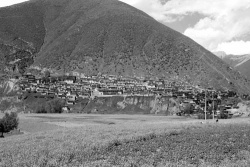Tongkor Monastery
Tongkor Monastery, Tongkor Gonpa, Ganden Chokhorling, or Dangar Gompa (Chinese: Donggu) is in Zithang township, Tongkor County = Kardze (Ch. Ganzi) county, Sichuan, not far to the east of Lake Koko Nor (Ch. Qinghai).
It about 30 km southwest of Tongkor Town (Ch. Huangyuan) which is itself about equidistant between Dabzhi (Ch. Haiyan) to the northwest, and about 40 kilometres from Ziling (Ch. Xining) City, the provincial capital in the southeast. It is 8 km northeast of the Nyima Dawa La or 'Sun and Moon Pass,' 3,399 metre (11,152 ft), over which the ancient trade route (now Route 214) from Ziling/Xining crossed south to Lhasa.
The town
The American adventurer and diplomat, W. W. Rockhill, refers to the town as Tankar (Tan-ka-erh), but adds this note:
- "Huc calls it Tang-keou-eul and Prjevalsky calls it Tonkir or Donkir. Tibetans and Mongols Name it Dung kor or Tung kor. The Name is not Chinese: it may be t'ang mk'ar "fort (commanding) the steppe," if it is a Tibetan Name, of which I am not sure."
Rockhill reports that late in the 19th century there was a massacre of nearly 10,000 Muslims around the town of "Tankar", but there were still "not more" than 10,000 Chinese and Tibetans in the town; with a "nominal force of 200 men under a colonel". Muslims were no longer allowed entry.
The town was walled and was an important trade centre. The journey from Tongkor to Lhasa was usually sixty to seventy days. Rockhill mentions that its importance as a trade centre had diminished since the recent War.
Items brought from Lhasa included woollen cloth of various colours and qualities, Incense sticks, the best quality K'a ch'é shakama saffron from Kashmir, Buddhist Books, dried dates and brown sugar from India, cowries, disks of chank-shells and amber for ornaments, furs and a few other items. Among the most valuable items brought by Tibetans or, more frequently, Nepalese, are Conch shells with their whorls turning to the Right. They are highly valued and used in the Monasteries as trumpets (Tib. Yä-chyil dung-kar) and are classed among the jewels. One of them could sell for from four to five hundred taels. The Chinese also placed a high value on them. A few traders from Khotan and Kashgar visited each year, usually in the autumn, bringing Khotan rugs, Hami raisins, dried melons and a few other things of little value. The exports contain goods of much higher value, including mules and horses, satin, silks and gold brocades, chinaware, and so on.
The Monastery
The Monastery is about 30 km southwest of Tongkor Town (Ch. Huangyuan) which is itself about equidistant between Dabzhi (Ch. Haiyan) to the northwest, and about 40 kilometres from Ziling (Ch. Xining) City, the provincial capital in the southeast. It is 8 km northeast of the 3,399 metre (11,152 ft) the Nyima Dawa La or 'Sun and Moon Pass' over which the ancient trade route (now Route 214) from Ziling/Xining crossed south to Lhasa.
History
The Monastery was founded by Tongkor I, Dawa Gyaltsen, in 15th century. It was previously the largest Monastery in the county with some 500 Monks about the beginning of the 20th century. This had dropped to about 70 Monks at the Time of the 2008 crackdown.
Description
The Monastery is now mostly in ruins. The remains of Ladrolne Gompa and Rali Hermitage may be seen between Haiyan and Tongkor. A branch of Tongkor Monastery, known as Ganden Tengyeling (Ch. Cinghosi), just to the northwest of the town of Tongkor is also in ruins.
Nyima Dawa La Pass
This pass was made famous due to its association with Princess Wencheng when she was en route to marry King Songtsen Gampo in the 7th century. She is said to have looked in a magic mirror here with a sun-moon design which was supposed to show her family in Chang'an. She only saw her own reflection and she smashed the mirror in despair. The nearby River which, unusually in these parts flows east to west is said to have originated from the tears of the princess. Every year about the 6th day of the 6th lunar month a Flower Song Festival (Ch. Huarhui) is held here. Two small new concrete temples have been built on the pass with modern murals showing the royal couple and scenes of nomadic Life.
2008 Crackdown
- "On April 3, 2008, troops fired upon protesters from Tongkor (Chinese: Donggu) Monastery, 60 kilometers from Kardze town, killing at least 10 people. The protests were sparked by a raid on the Monastery by police, the detention of a senior Monk, and resentment over intensified Patriotic Education."
Some accounts claim up to 14 people were killed.
